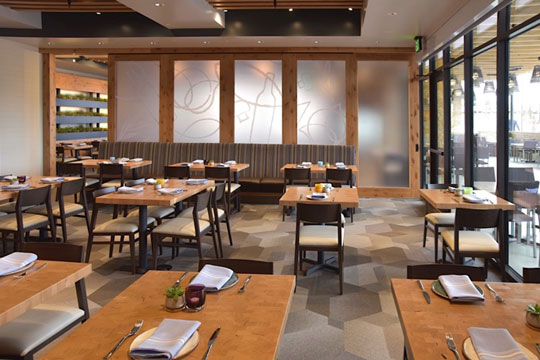Savor Genuine Oriental Food With a Pan-Asian Spin for a Culinary Journey
Starting a culinary journey through genuine Oriental food, boosted with a Pan-Asian spin, supplies an one-of-a-kind possibility to explore the rich tapestry of tastes that specify the area's diverse cooking traditions. This experience welcomes you to savor the exquisite balance of tastes-- pleasant, salty, spicy, and sour-- harmonized by fragrant natural herbs and spices. Visualize the ingenious combination of Thai curry and ramen or the unforeseen delight of sushi burritos. As you consider these enticing dishes, think about the cultural narratives and historical influences that form them, each bite using a tale waiting to be uncovered.

Checking Out Pan-Asian Flavors
In the realm of worldwide gastronomy, Pan-Asian cuisine stands apart for its impressive diversity and the unified interaction of flavors from numerous Oriental cultures. This culinary method celebrates the abundant customs and unique active ingredients found across the continent, developing a tapestry of tastes that is both rewarding and interesting. Key to Pan-Asian cuisine is its capacity to stabilize contrasting flavors-- pleasant, salted, spicy, and sour-- while highlighting the freshness and high quality of each ingredient.
From the umami-rich soy sauce of Japan to the fiery chili peppers of Thailand, Pan-Asian food supplies a considerable combination of flavors. These components are commonly integrated in creative ways, improving recipes with layers of complexity. As an example, making use of fragrant herbs such as lemongrass and cilantro, usual in Vietnamese and Thai cuisine, adds a refreshing illumination to meals, while the incorporation of coconut milk delivers a creamy, abundant appearance.
The focus on fresh produce and aromatic spices makes certain that each meal is not only a banquet for the taste but also for the senses. Pan-Asian cuisine invites diners to start a culinary journey, checking out the substantial and varied landscapes of Oriental gastronomy with every bite.
Combination Recipes to Try
While Pan-Asian food is commemorated for its conventional tastes, the contemporary cooking landscape is progressively embracing fusion dishes that mix these timeless elements with influences from various other regions. This innovative approach not only honors the rich heritage of Oriental cookeries yet likewise presents novel preference experiences that interest contemporary tastes.
A prime example of such a combination recipe is the Korean-Mexican taco, where seasoned bulgogi beef is covered in a warm tortilla, covered with kimchi and a zesty gochujang-infused salsa. This combination marries the strong, tasty flavors of Korea with the lively, fresh aspects of Mexican cuisine. Likewise, sushi burritos have actually acquired popularity, amalgamating the delicate artistry of Japanese sushi with the hearty, hand-held convenience of a burrito, commonly featuring combination components like tempura shrimp and avocado with a drizzle of wasabi mayo.
One more significant recipe is Thai curry ramen, which instills the creamy, aromatic seasonings of Thai curry into the reassuring broth of conventional Japanese ramen, developing a harmonious blend that tantalizes the detects. These fusion recipes expand beyond simple novelty; they stand for a cooking dialogue in between societies, encouraging expedition and advancement on the planet of Pan-Asian food.
Necessary Ingredients and Spices
To absolutely value Pan-Asian food, one should recognize the vital active ingredients and spices that form its structure. This varied cooking design draws from an abundant tapestry of Eastern practices, employing an unified mix of tastes and textures. Key active ingredients include soy sauce, fish sauce, and oyster sauce, which impart a tasty umami deepness necessary to Oriental dishes. Complementary to these are rice vinegar and mirin, providing a delicate level of acidity and sweetness.
Aromatic components are crucial, with ginger, lemongrass, and garlic being common throughout different Pan-Asian dishes. These components offer an aromatic base that enhances the complexity of flavors. Seasonings such as star anise, cardamom, and cinnamon introduce warmth and personality, echoing impacts from regions like China and India.

Cooking Techniques and Tips
Understanding the art of Pan-Asian cuisine calls for knowledge with its distinct food preparation techniques, each adding to the lively tapestry of flavors this culinary custom is celebrated for. Central to these approaches is the stir-fry, pollo tropical near me a quick cooking strategy that protects the nutritional honesty and vibrant shades of active ingredients. Utilizing a frying pan, the stir-fry approach enables even heat circulation, vital for accomplishing the characteristic texture and taste balance of Pan-Asian dishes.
An additional basic method is steaming, particularly prevalent in Chinese cuisine. This gentle method keeps the natural flavors and nutrients of ingredients, making it suitable for seafood and vegetables. Dumplings, a precious staple, usually gain from steaming, causing soft, delicious structures.
Cooking, also integral, imparts great smoky midsts to recipes such as Korean bulgogi or Japanese yakitori (Best ambiance restaurants Islamabad). This technique usually involves marinating ingredients, allowing tastes to permeate deeply before cooking over an open fire or warm plate
Lastly, mastering the art of balancing tastes-- wonderful, sour, salted, bitter, and umami-- is critical. Correctly layering these elements can boost a dish from average to amazing, providing a facility and satisfying cooking experience that symbolizes the essence of Pan-Asian food.
Dining Experiences Worldwide
Around the world, Pan-Asian food offers an exceptional dining experience, commemorated for its rich tapestry of flavors and vivid discussions. This culinary sensation has gone beyond social limits, catching the hearts and tastes buds of food lovers worldwide. In worldwide cities fresh York, London, and Sydney, Pan-Asian restaurants offer as fusions where cooking customs from Thailand, Japan, China, and beyond assemble, providing restaurants with an eclectic mix of recipes that highlight the region's variety.
The international allure of Pan-Asian food hinges on its capability to offer both authenticity and innovation. Cooks skillfully wed traditional active ingredients such as lemongrass, soy sauce, and miso with contemporary methods, causing recipes that are both refreshingly new and acquainted. This combination permits diners to start a culinary journey that appreciates heritage while welcoming modernity.
Furthermore, eating experiences are raised via thoughtfully developed atmospheres that reflect the ethos of Pan-Asian aesthetics. From minimalist Japanese-inspired insides to vivid Thai-themed rooms, each dining establishment uses an unique ambiance that complements the culinary offerings. Consequently, clients are not merely eating a dish however partaking in a social experience, making Pan-Asian eating a truly global phenomenon.
Final Thought
The expedition of Pan-Asian food offers an extensive understanding of the complex interplay of tastes and culinary customs throughout Asia. By welcoming fusion recipes such as Thai curry ramen and sushi burritos, the culinary journey not only highlights the flexibility of standard active ingredients yet additionally showcases cutting-edge modern-day strategies. This gastronomic experience, enriched by cooking approaches and important flavors, gives a distinct possibility to value the social variety and cooking artistry that define Pan-Asian food on a global scale.
Embarking on a cooking trip with genuine Asian food, enhanced with a Pan-Asian spin, uses a distinct opportunity to check out the abundant tapestry of flavors that define the area's varied culinary customs.In the world of global gastronomy, Pan-Asian food stands out for its exceptional variety and the harmonious interplay of flavors from numerous Eastern cultures. Key to this article Pan-Asian food is its capability to stabilize different tastes-- sweet, salty, spicy, and sour-- while highlighting the quality and quality of each ingredient.
